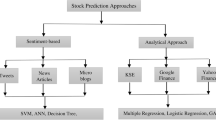Abstract
Krueger and Kennedy (J Fin 45:691–697, 1990) were the first to empirically document the remarkable stock market predictive power of the winner of the Super Bowl. The original model had investors go “long” in the market when the Super Bowl was won by a team from the old NFL, but park their money in T-Bills when the Super Bowl was won by a team from the old AFL—a non-symmetric trading rule. We create a symmetric rule (go “long” in the market when the old NFL wins; go “short” when they lose) and compare its efficacy to the original formulation. The symmetric rule outperforms the original KK specification in the period covered by their study (1967–1988), but performs worse than the original specification (and the naïve buy-and-hold strategy) since 1988.
Similar content being viewed by others
Notes
Technical trading rules appear to have been employed in Japanese rice markets since the 1700s. See Homma Munehisa San-en Kinsen Hiniku (1755), as described in Beyond Candlesticks: New Japanese Charting Techniques Revealed by Nison (1994).
See Alexander (1961) for an early test.
The authors report abnormal returns earned by the SBPM using five different market indices.
See Fehle et al. (2005) for evidence of rates of return earned by shareholders of firms that advertise during the Super Bowl.
The rate of return on the SP500 and the DJIA was in excess of 30 % in the year following Tampa Bay’s victory in the 2002 Super Bowl. Treating Tampa Bay as if it were a member of the old NFL biases our results in favor of the SBPM. Treating Tampa Bay as an old AFL team would have reduced the returns credited to the original SBPM in the 1988–2013 period anywhere from 2.7 to 3.2 % (compounded) and would have reduced the returns credited to the symmetric SBPM by similar amounts.
Nothing sinister is meant by this use of emphasis. Professors Krueger and Kennedy reported the facts as they existed and closed their article with the following statement: “While the SB SMP has been extremely accurate over the past 22 years, there is no assurance that the predictor’s accuracy will continue in the future, particularly because the theoretical relationship connecting the Super Bowl and subsequent stock movements is not obvious.” As subsequent results show, this caution was quite appropriate.
Professors Krueger and Kennedy employed a 1 % transaction cost charge; subsequent authors use smaller rates (e.g., 0.25 %). Thus, using a zero transaction cost is the most favorable treatment that can be afforded the SBPM.
References
Alexander, S.S.: Price movements in speculative markets: trends or random walks? Ind. Manag. Rev. 2, 7–26 (1961)
Dyl, E., Shatzberg, J.D.: Did Joe Montana save the stock market? Fin. Anal. J. 4–5 (1989)
Fama, E.: The behavior of stock market prices. J. Bus. 38(1), 34–105 (1965)
Fama, E., Blume, M.E.: Filter rules and stock-market trading. J. Bus. 39(1), 226–241 (1966)
Fehle, F., Tsyplakov, S., Zdorovtsov, V.: Can companies influence investor behavior through advertising: Super Bowl commercials and stock returns. Eur. Fin. Manag. 11(5), 625–647 (2005)
Kester, G.W.: What happened to the Super Bowl market predictor? J. Invest. 19(1), 82–87 (2010)
Koppett, L.: Carrying statistics to extreme. Sports News, February 11 (1978)
Krueger, T.M., Kennedy, W.F.: An examination of the Super Bowl stock market predictor. J. Fin. 45(2), 691–697 (1990)
McLean, R.D., Pontiff, J.: Does academic research destroy stock return predictability? Unpublished working paper (2012)
Nison, S.: Beyond Candlesticks: New Japanese Charting Techniques Revealed. Wiley, New York (1994)
Rayhorn, C.R., Drosen, J.W., Janson, K.R.: Following the football: short-term market reaction to a potentially spurious intermediate-term leading indicator. J. Bus. Behav. Sci. 25(1), 168–177 (2013)
Acknowledgments
The authors thank the anonymous referee for comments and suggestions.
Author information
Authors and Affiliations
Corresponding author
Rights and permissions
About this article
Cite this article
Born, J.A., Acherqui, Y. A symmetric Super Bowl stock market predictor model. Financ Mark Portf Manag 29, 115–124 (2015). https://doi.org/10.1007/s11408-015-0247-3
Published:
Issue Date:
DOI: https://doi.org/10.1007/s11408-015-0247-3




